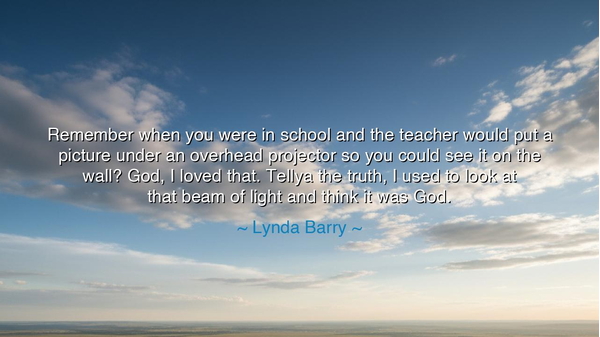
Remember when you were in school and the teacher would put a
Remember when you were in school and the teacher would put a picture under an overhead projector so you could see it on the wall? God, I loved that. Tellya the truth, I used to look at that beam of light and think it was God.






The cartoonist and teacher of imagination, Lynda Barry, once confessed with childlike wonder: “Remember when you were in school and the teacher would put a picture under an overhead projector so you could see it on the wall? God, I loved that. Tellya the truth, I used to look at that beam of light and think it was God.” In these words we hear the voice of one who has never ceased to see the sacred in the ordinary, one who understood that even the simplest act of learning—a picture projected on a wall—can become a vision of transcendence. For the child does not separate the holy from the common; to the child, even a beam of light may be divine.
The overhead projector, now a relic of schools past, was once a vessel of magic. A teacher placed upon it a sheet of words or images, and instantly, by the alchemy of light, the small became large, the hidden became visible, and the obscure was made clear. To the student, it was more than a machine; it was a gateway. Barry remembers not only the lesson but the beam itself—a shaft of pure radiance, carrying knowledge from paper to wall, from teacher to student. In that beam she glimpsed something eternal, something beyond human invention. She saw in its brightness the same mystery that men have called God.
There is great wisdom in this vision. For is not God also the unseen light that reveals all things? Just as the beam of the projector brings forth the image hidden in a small transparency, so does the divine light bring forth the hidden truths of the world, casting them onto the walls of our understanding. Without the beam, the picture remains invisible; without the light of God, the meaning of life remains concealed. Barry’s childhood awe was therefore no accident—it was a recognition, in miniature, of the eternal truth that light reveals.
History bears witness to this pattern. The philosopher Plato, in his allegory of the cave, spoke of men chained in darkness, mistaking shadows for reality until one is brought into the light of the sun. The sun, he taught, is a symbol of the Good, the ultimate source of truth. Centuries later, Barry as a schoolchild beheld the beam of the projector and, in her innocence, felt the same lesson: that the light which makes things visible is also the light which awakens the soul. What Plato clothed in philosophy, Barry clothed in memory and wonder.
This reflection also reminds us of the sacrament of the ordinary. Too often, as adults, we lose the child’s vision and pass by small wonders without reverence. We see only a machine, only a classroom, only a beam of light. But the child, and the artist who remembers being a child, sees more: a mystery, a metaphor, a whisper of the infinite. By such seeing, the ordinary is transfigured. The overhead projector becomes a temple, and its beam a reminder that knowledge, like divinity, comes through illumination.
The lesson for us is profound: do not overlook the light. Learn again to see with the eyes of wonder. Recognize that in the smallest of things—a tool, a gesture, a moment—there may dwell a revelation of the eternal. The projector’s beam may have been only photons, but to a child it was holiness. Likewise, in our own lives, we may encounter divine meaning in the commonplace, if only we look with reverence.
Practically, this means cultivating attentiveness. Pause in the presence of light—sunlight through leaves, lamplight on a page, the glow of a screen—and remember that it is light which makes knowledge and beauty possible. Encourage children, and yourselves, to see not only what is shown, but also what shows it. Let us honor teachers, too, for like the projector’s beam, they stand between what is hidden and what is revealed, carrying knowledge into the sight of the young.
Thus, Barry’s words are not mere nostalgia; they are a teaching. The beam of light is God—not in the sense of machinery becoming divine, but in the sense that all true light, all revelation, all illumination, is a shadow of the Eternal. To see this is to reclaim the vision of the child, who, gazing at the beam in wonder, knows instinctively what the wise spend lifetimes trying to remember: that light itself is sacred, and in it we glimpse the face of truth.






AAdministratorAdministrator
Welcome, honored guests. Please leave a comment, we will respond soon